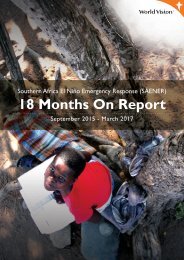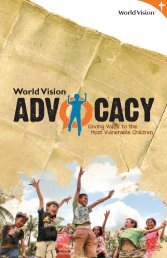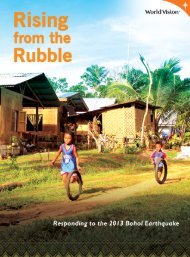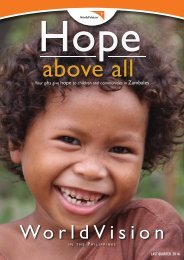INTER-AGENCY LIVELIHOOD ASSESSMENT - ARUA DISTRICT NORTHERN UGANDA GOAL
Create successful ePaper yourself
Turn your PDF publications into a flip-book with our unique Google optimized e-Paper software.
LIMITATIONS<br />
• The questionnaire was in English and in some cases enumerators had to translate the question<br />
to the local language. There is a chance of distortion/loss of the real meaning in translation.<br />
• Inaccurate recall and quantitative estimates by some of the respondents could compromise the<br />
level of validity of some the study findings.<br />
• Respondents’ expectations for the assessment’s hidden benefits could influence their<br />
responses.<br />
<strong>ASSESSMENT</strong> FINDINGS<br />
Household Characteristics<br />
The assessment covered 1,135 households in Imvepi and Adjumani settlements. Out of the sampled<br />
1,135 people, 69% were refugee households, and 31% were citizens of the host communities, in line<br />
with the guidelines provided by UNHCR and REHOPE framework. The survey targeted the household<br />
heads as the most appropriate respondents and, in cases where the head was not available or did not<br />
want to be interviewed, an adult member of the households was interviewed instead with permission<br />
from the household head. This approach ensured that all targeted households were interviewed. As<br />
such, 80% of the respondents were household heads were selected, while 20% were representatives.<br />
This approach was primarily selected because the delegated representative since s/he was a member<br />
of the household was deemed to be well informed about issues of that household, and therefore the<br />
information provided is considered reliable.<br />
Overall, 57% of the respondents were female, and 43% were male respondents.<br />
Figure 1: Household Heads Interviewed<br />
Figure 2: Sex of Household Heads Interviewed<br />
Household Head<br />
Sex of Respondent<br />
0.1991<br />
0.8009<br />
Yes<br />
No<br />
0.5683<br />
0.4317<br />
Male<br />
Female<br />
Demography<br />
The majority, 62% of the refugee households, were headed by females and only 38% of the<br />
households were male-headed. Most of the female-headed refugee households reported that their<br />
husbands had either been killed or had gone back to South Sudan to secure household assets. On<br />
the other hand, among the host communities, the demography was a fair representation of normal<br />
demographic characteristics in most rural areas of Uganda, male-headed households were the<br />
majority at 72% while female-headed comprised 28%.<br />
10<br />
<strong>INTER</strong>-<strong>AGENCY</strong> <strong>LIVELIHOOD</strong> <strong>ASSESSMENT</strong> TARGETING REFUGEES AND<br />
HOST COMMUNITIES IN MVEPI AND RHINO CAMP SETTLEMNTS










